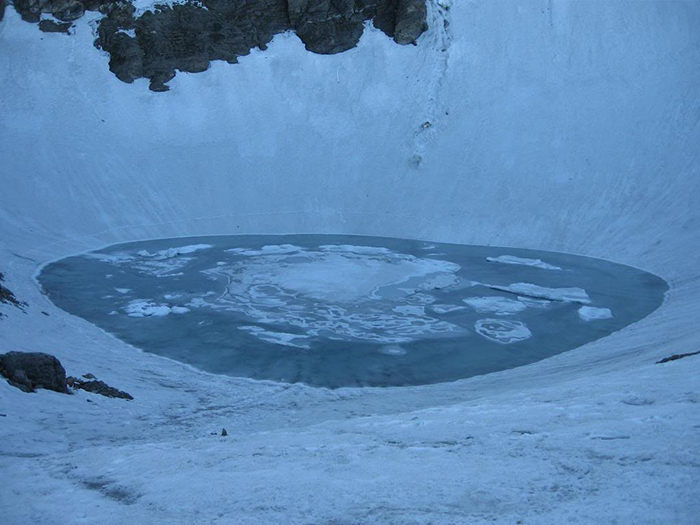Famously known as the mystery lake in India, the Roopkund has taken its seat at an astounding height of 5,029 metres above sea level in Chamoli district of Uttarakhand. While, avid trekkers are attracted to its unsolved mystery, the nature lovers are lured by its serenity and tranquillity. This mystical lake is famous for the skeletons of humans and horses that are found near this lake which dates back to circa 850 A.D.
Many inquisitive people who visit this glacial lake are left in awe with their jaws dropping in surprise and a bone chilling feeling runs down through their spine when they witness the dreadful sight of hundreds of skeletons floating on the glacial lake of Roopkund. There are several tales associated with this lake one of which tells, the remains belong to the Japanese soldiers who trespassed this area and had entered into the ravages of the hostile terrains. When the matter was brought to the light, an examination was conducted. It was found that these bones did not belong to the Japanese soldiers and the corpses were a century old.

Roopkund Lake in winters Photo Src: undiscoveredindiantreasures.blogspot.in
Many theories suggest that the people might have died due to an epidemic, landslide or because of a ritual suicide. While some British explorers believe, the bones belong to the General Zorawar Singh’s army who lost their way and died in the lap of Himalayas while returning home after the Battle of Tibet in 1841. Many historians are of the opinion that these corpses belong to an unsuccessful attack by Mohammad Tughlak on the Garhwal Himalayas.

Skeletons near Roopkund Lake Photo Src: upload.wikimedia.org
Another theory states that in the medieval era, King Jasdhawal of Kanauj wanted to celebrate the birth of his heir by commencing a pilgrimage to the Nanda-Devi Mountains in the Garhwal Himalayas. But as they ascended, the entourage became boisterous with singing and dancing. Soon after, the wrath of a local deity, Latu befell on them in the form of a terrible hailstorm and the people were thrown into the Roopkund Lake.
According to a famous Hindu mythological tale, Goddess Parvati was mesmerized by looking at her beautiful reflection in the Roopkund Lake and gave half of her beauty to the lake. Undoubtfully, this lake is utterly beautiful and is blessed with nature’s munificence. One can have a panoramic view of the enchanting Trishuli, Nandaghunti and other spectacular peaks from here. While another legend states that when Lord Shiva and Goddess Parvati were on their way to Kailash Parvat, Parvati who had killed a demon wanted to clean her. Lord Shiva then created a lake with his Trishul. When Parvati took a dip in its crystal clear water she could easily her beautiful reflection in the lake. Hence, the lake was named as Roopkund.

Photo Src: www.rachnabisht.com
In an operation carried in 2004 it was found that all the bodies dated back to 850 AD and the DNA evidence indicated that these skeletons belonged to two distinct groups of people, one family or tribe of closely related individuals, and a smaller, shorter group of locals, likely hired as porters and guides. Also, rings, spears, leather, shoes and bamboo staves were found which made the experts believe that the group was comprised of the pilgrims heading through the valley with the help of the locals.
The experts also believed that the short deep cracks in the skulls were not from weapons but something that is round in shape. The bodies only had wounds on their heads and shoulders as if the blows had only come from directly above. However, the mystery remains unsolved.

The Glacial Roopkund Lake Photo Src: www.hellotravel.com
There is a popular folk song whose lyrics suggests that once the goddess was so enraged on the intruders for tarnishing her mountain sanctuary that she showed her wrath by raining hailstones as “hard as iron.” These hailstones were estimated to be the size of a cricket ball which resulted in the sudden death of the travellers. The skeletons remained in the lake for around 1,200 years until they were discovered. Hence, it made the research of 2004 true which states that around 200 people died from a sudden and severe hailstorm.
nice article keep writing !
Wow. Great article. And the way you write, its just amazing.